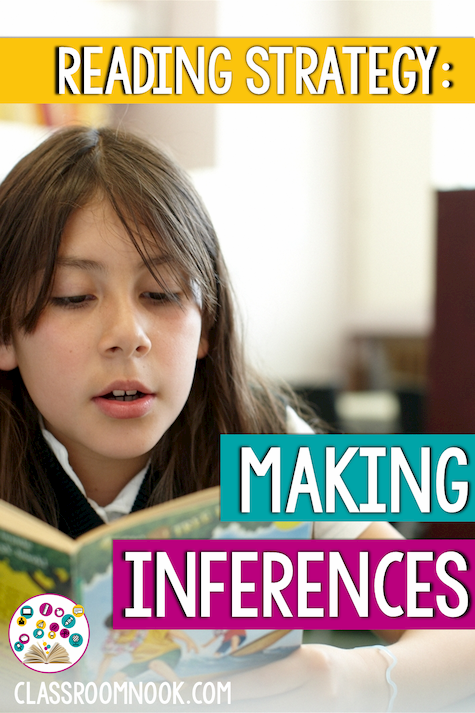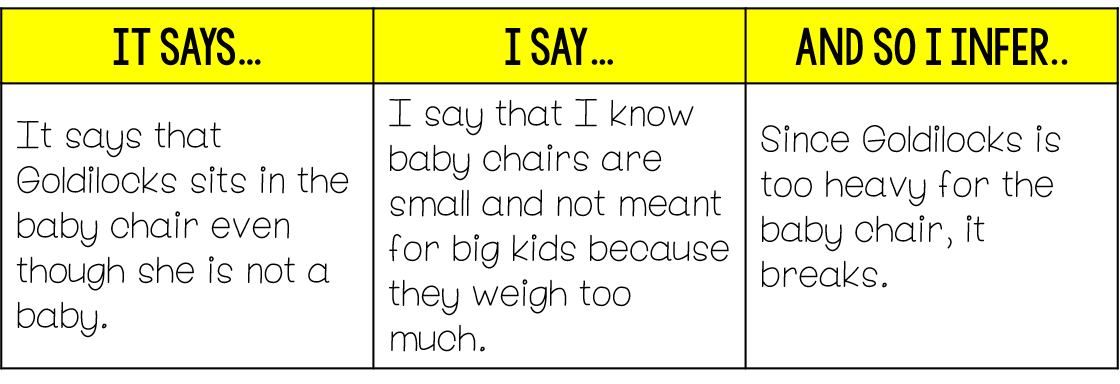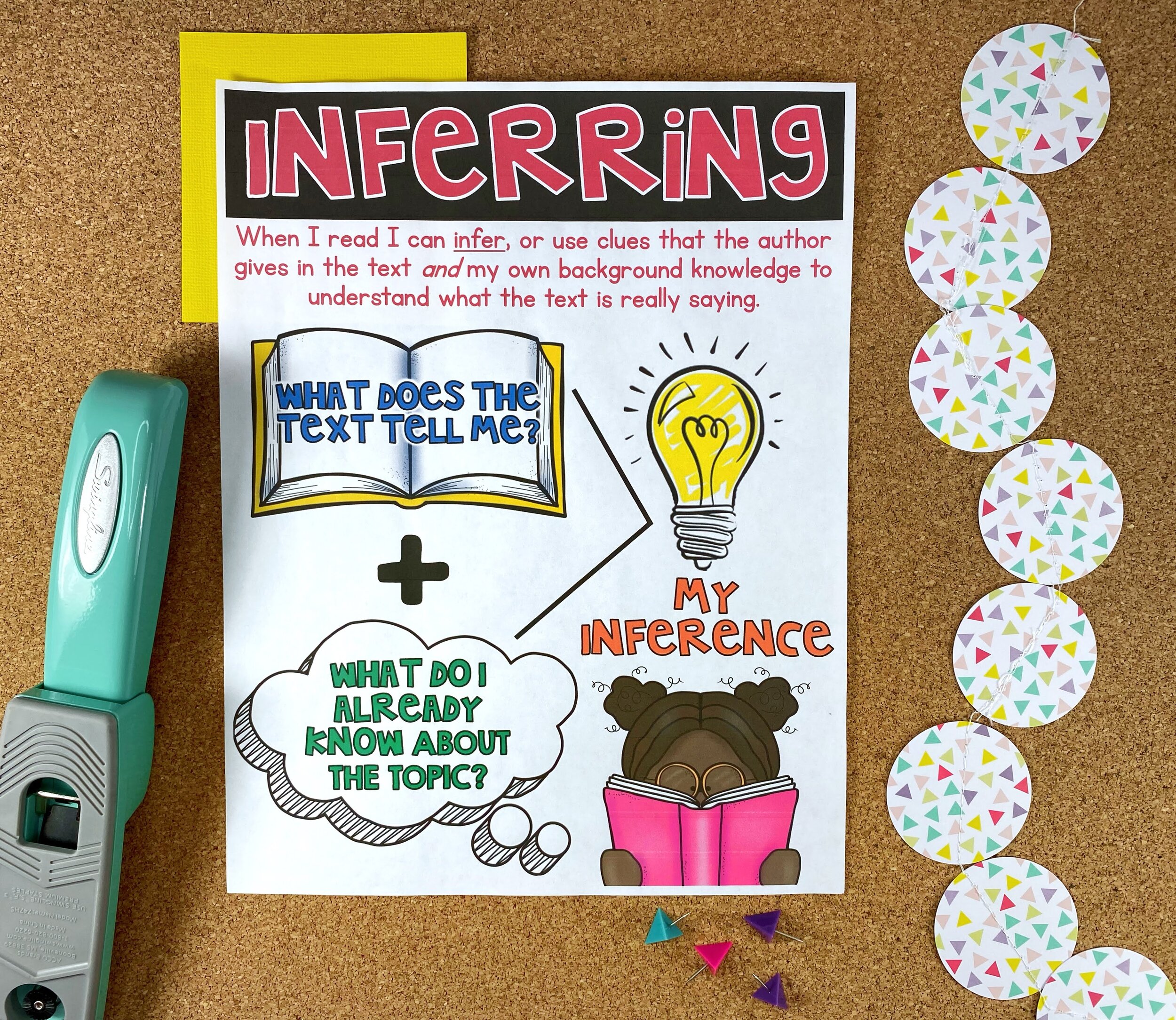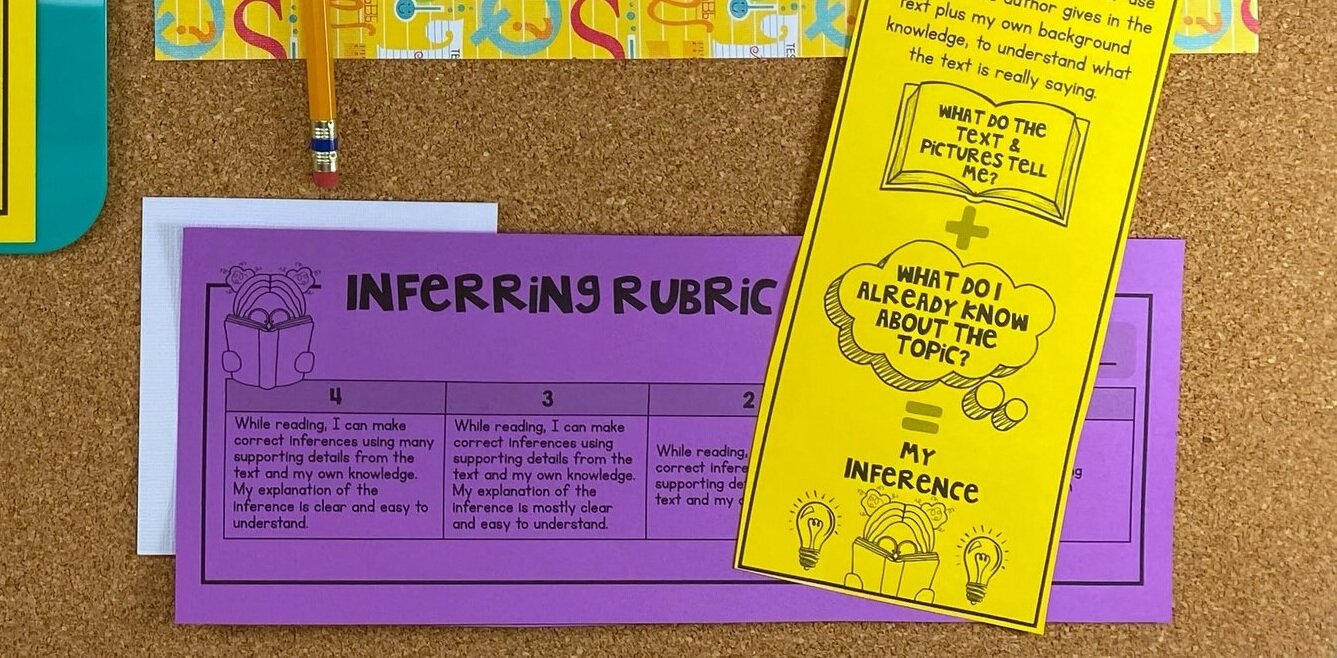How Does the Infer Strategy Help You Read?
Reading Comprehension Strategy Series: How to Teach Students to Infer While Reading

Instruction students how to infer while reading is a primal reading strategy that will help them take their pregnant of a text deeper.
When students infer, they find clues in the text and use what they already know from personal feel or past noesis to fully understand what the text is about.
Good inferences are backed upwardly by supporting details from both the text and personal knowledge.
But — before students tin infer, they have to be explicitly taught how. In this post, we'll uncover the essentials for how to teach inferring to your students.
Pssst…Want a super engaging and interactive style to have students exercise inferring?
LINKtivity® Interactive Guides are EXACTLY what yous need to brand learning fun & accessible for all!
Become admission to the Inferring LINKtivity® (+60 others and counting!) inside of LINKtivity® Learning - an all-access pass to our entire vault of LINKtivities!
Below are the different categories inside this postal service to help you spring to exactly what you demand! Click on each category title to navigate at that place direct:
<< Back to categories
what you need to know before education the inferring reading strategy:
Information technology's important to help students to distinguish inferring from stating the obvious. For case, a student looking at the picture of the baby could state the obvious by proverb the infant is crying. Nonetheless, a correct inference might include that the baby is tired or hungry. Using background cognition of why babies weep, combined with the details in the picture makes this a plausible inference.
It is also important to assistance students understand the divergence between inferences and predictions. Although they are relatable, they are non the same. When students predict, they guess what will happen side by side based on what they already know from the text and their background knowledge. When students infer, they make a gauge about what is currently happening. A sensible inference for why the baby is currently crying is that the baby is hungry or tired, while a sensible prediction might be that the mom or dad of the infant will come and choice the infant up to sooth him.
Finally, although inferences are subjective, information technology is possible for students to draw incorrect inferences. For example, if a student looked at the movie of the crying baby and said "the baby is probably upset because his brother just made fun of him," that would be incorrect because the infant in this picture is too immature to sympathize that he was being fabricated fun of.
Setting this foundation will be essential to your students' principal of this reading strategy.
<< Dorsum to categories
Introduce the Reading Strategy
There are several activities that will help students to make inferences. First, help students to empathise that they are already making inferences in their everyday life. Whatever time that they come to a conclusion most a specific state of affairs, they are inferring.
An easy way to showtime innovate inferring is to use pictures. Show students several pictures that lend themselves to making inferences is a great way to get students to apply their inferring skills. Here are couple of examples of what your pictures might look similar:

Possible inference: The male child does not like vegetables.
Prove: He has a plate of veggies in front of him and a scowl on his confront. The student might use his/her own feelings most veggies to sympathise what he might be thinking.

Possible inference: The girl wants to buy chips, but her mom is not going to allow it.
Show: The girl looks similar she is hopeful her mom might let her put the fries in the shopping cart, but the mom is property upwardly her hand as if to say "no."
Another fun manner to introduce inferring is to create mystery numberless. Collect several items that students can use as clues to guess where you might be going or what y'all might be doing. For example, one bag might have a pair of sunglasses, some sunscreen, and a beach towel. Students would approximate that you might exist going to the embankment. Another purse might include ingredients and utensils needed to make a peanut meliorate and jelly sandwich. Extend this activity by having students create their ain mystery bags. Invite a few students at a time to share their bag with the class while their classmates make inferences.
Like to the mystery bag, you could play game where students observe unlike shoes and guess which type of person would vesture that shoe. For case, a high-heel shoe would be worn past a women, mayhap going to a fancy restaurant. A soccer cleat would be worn past a soccer histrion, a winter kicking would be worn by someone planning to walk in the snowfall…etc.
<< Back to categories
Modeling the Inferring Reading Strategy
Once students empathise the concept of making inferences based on clues, assist them to translate the skill into their reading. Earlier jumping into longer stories, however, accept students practice their inferring skills using brusk sentences. Here are some sample sentences where students can be asked to draw inferences:
-
My family and I accept everything we demand: tickets, popcorn, and candy! (Inference: The family is going to a movie)
-
•Sam sat with a puzzled await on his face and and then raised his mitt in form. (Inference: Sam has a question or is confused about something)
-
•We all grabbed our raincoats and umbrellas. (Inference: It's raining outside)
The adjacent stride is enquire students to apply this reading strategy to longer stories. Movie books tin be a peachy tool to model the strategy of inferring. You might even beginning with wordless picture books as they are perfect for practicing inferring. See volume suggestions at the end of this guide for a list of books that you tin can utilize to model the strategy.
Teach students that skilful inferences use specific details from the text as well as their background cognition. 1 strategy suggested by author and educator Kylene Beers that tin can be used to model inferring is called the "It says…I say…and then…" thought menstruation.
Check out how this strategy looks in activeness using the story Goldilocks and the Three Little Bears. Students are inferring why the baby chair broke when Goldilocks went to sit in information technology.

<< Back to categories
CHOOSE TEXTS THAT Help IN MAKING INFERENCES:
Use several pictures books to model this "It Says, I Say, and So…" idea flow. Then, allow students to use this same thought period with their independent reading books. Yous may even want to provide them with a graphic organizer like the one shown to a higher place for them to record their thoughts. This volition brand it easy for you to assess how they are connecting text evidence and background knowledge to make their inferences. The students' success in using this reading strategy begins with choosing ballast texts that best support making inferences. Here are some of my favorites to use when modeling this strategy (affiliate links):
-
The Wretched Stone by Chris Van Allsburg
-
The Memory String by Eve Bunting
-
This Is Not My Hat by Task Klassen
-
The Other Side by Jacqueline Woodson
<< Back to categories
PRACTICING Making Inferences
CREATE Simple VISUALS TO REMIND STUDENTS TO INFER

When first using a new reading strategy, students need constant reminders. Visuals such as bookmark to use while reading, or a classroom poster that is displayed on a reading strategy bulletin board work wonderfully to aid students remember to use their own experiences and cognition, combined with clues in the text, to infer in the books they read.
Continue to create ballast charts displaying inferences that yous make during read-alouds.

eight FREE Reading Strategy Bookmarks
Take hold of these Gratuitous pupil bookmarks to help your students use reading comprehension strategies while reading.
There are a full of 8 bookmarks that explain reading strategy in kid-friendly language and is the perfect reference for students to use during independent or small-group reading time.
USE LINKtivity DIGITAL LEARNING GUIDES
New to LINKtivities? >> CLICK HERE
Did someone say "LINKtivity"?" Why, yeah I Practise accept a LINKtivity for making inferences!
It'south easy to appoint students when you've got an interactive, easy-to-use LINKtivity bachelor!
Bank check out the video below to get a sneak-peek
In the Inferring LINKtivity, students beginning watch a short animated video prune that chop-chop catches their attention with fun doodles and images. The clip introduces what the strategy is and how readers use information technology.
From in that location they read aslope their "virtual reading buddy" to encounter the strategy practical to a text. While clicking through the digital book, each time the student comes across a thought chimera, they click on information technology and are brought to a new slide in the LINKtivity guide to run across what their reading buddy is thinking!
Then, to have their learning to the next level, students read 3 additional high-interest reading passages to practice the strategy on their own. In a similar way as they did with their reading buddy, students click through the digital storybook and stop to make inferences along the way. The students can record their thinking on a recording sheet that goes along with the LINKtivity.
Take STUDENTS KEEP TRACK OF THEIR INFERENCES WHILE READING

Having students write down their inferences is key when it comes to informing you of their agreement of the strategy. From their written details you can see if they tin can make logical inferences.
Writing down their thoughts likewise keeps them accountable for their learning and gives you an breezy cess.
<< Back to categories
ASSESSING YOUR STUDENTS ON Making Inferences

Cess, whether it be formal or informal, drives educational activity. For more informal assessments, accept notes about a students use of the inferring reading strategy during reading conferences or in small groups. Considering the following when observing the students' use of the strategy:
-
Are students using text bear witness to support their inferences?
-
Are students using background knowledge and/or personal experiences to support their inferences?
-
Are their inferences logical?
-
Can students conspicuously justify their inferences?
Finally, having a rubric written in kid-friendly linguistic communication is especially helpful when providing feedback to a pupil on their ability to brand inferences. The rubric can provide clear guidelines on how to infer while reading.
<< Back to categories
Resources for inferring

Want to get your easily on the Inferring LINKtivity®?
Join the LINKtivity® Learning Membership and first using this ready-to-become resource for making inferences that includes:
-
a instructor guide
-
a pupil LINKtivity
-
a pupil recording sheet
-
a student-friendly rubric
Go access to the Inferring LINKtivity® PLUS all the other reading comprehension strategies within of LINKtivity® Learning - an ALL-ACCESS pass to every single LINKtivity® created (INCLUDING all 7 reading strategy LINKtivities!)
Check out the other posts in this series
Source: https://www.classroomnook.com/blog/making-inferences#:~:text=Teaching%20students%20how%20to%20infer,what%20the%20text%20is%20about.
0 Response to "How Does the Infer Strategy Help You Read?"
Post a Comment